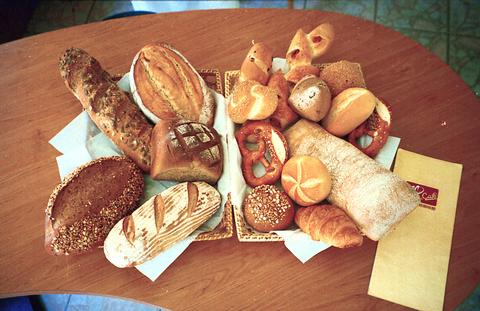Unlike many of Taipei's bakeries that fill their window displays with birthday cakes, breads of differing appearances and pastries of all shapes, the huge glass facade of the Wendel Backerei & Cafe reveals little of the expert baking that takes place within.
The German-style bakery is so unlike many of the city's more ostentatious bakeries in fact, that you could quite easily amble past without noticing it at all. That would be a shame if you enjoy baked goods.

PHOTO: GAVIN PHIPPS, TAIPEI TIMES
For the past two years, German national, Michael Wendel, has been baking up a smorgasbord of some of the most authentic Europe breads, including rye, grain, pumpkin and pumpernickel, rolls, cakes, pies and pretzels to be found in Taipei.
"I don't make my bread or cakes to suit local tastes," Wendel said. "I make sure they're all authentic." By authentic, Wendel means the breads aren't loaded with sugar and other sweeteners, which is one of the main reasons behind his bakery's popularity.
Wendel's store is also popular as a very reasonably-priced European-style bistro, offering diners a choice of savory German fare, such as smoked pork loin, roast chicken, Nurnberger sausage, Frankfurters, mashed potatoes and, of course, sauerkraut.
With set meals ranging in price from NT$110 to NT$260, dining at Wendel's certainly won't break the bank. What could give diners a dilemma, however, is choosing a dessert.
Along with such German staples as Black Forest cake, apple cake, Linzer torte and butter cake, there are countless other yummy pastries, pies and cakes to confound any sweet-toothed diner.
While there is little in the way of interior decor to the Wendel Backerei & Cafe, patrons are afforded a pleasant and airy environment in which to dine on simple and hearty German cuisine. The menu also includes several pasta dishes (NT$100 to NT$120) and submarine sandwiches (NT$90 to NT$110).
In addition to baking up a daily selection of rolls, breads and pastries, Wendel will prepare special breads and bulk orders on request -- should the ingredients be available.

US President Donald Trump may have hoped for an impromptu talk with his old friend Kim Jong-un during a recent trip to Asia, but analysts say the increasingly emboldened North Korean despot had few good reasons to join the photo-op. Trump sent repeated overtures to Kim during his barnstorming tour of Asia, saying he was “100 percent” open to a meeting and even bucking decades of US policy by conceding that North Korea was “sort of a nuclear power.” But Pyongyang kept mum on the invitation, instead firing off missiles and sending its foreign minister to Russia and Belarus, with whom it

Many people noticed the flood of pro-China propaganda across a number of venues in recent weeks that looks like a coordinated assault on US Taiwan policy. It does look like an effort intended to influence the US before the meeting between US President Donald Trump and Chinese dictator Xi Jinping (習近平) over the weekend. Jennifer Kavanagh’s piece in the New York Times in September appears to be the opening strike of the current campaign. She followed up last week in the Lowy Interpreter, blaming the US for causing the PRC to escalate in the Philippines and Taiwan, saying that as

When Taiwan was battered by storms this summer, the only crumb of comfort I could take was knowing that some advice I’d drafted several weeks earlier had been correct. Regarding the Southern Cross-Island Highway (南橫公路), a spectacular high-elevation route connecting Taiwan’s southwest with the country’s southeast, I’d written: “The precarious existence of this road cannot be overstated; those hoping to drive or ride all the way across should have a backup plan.” As this article was going to press, the middle section of the highway, between Meishankou (梅山口) in Kaohsiung and Siangyang (向陽) in Taitung County, was still closed to outsiders

The Chinese Communist Party (CCP) has a dystopian, radical and dangerous conception of itself. Few are aware of this very fundamental difference between how they view power and how the rest of the world does. Even those of us who have lived in China sometimes fall back into the trap of viewing it through the lens of the power relationships common throughout the rest of the world, instead of understanding the CCP as it conceives of itself. Broadly speaking, the concepts of the people, race, culture, civilization, nation, government and religion are separate, though often overlapping and intertwined. A government